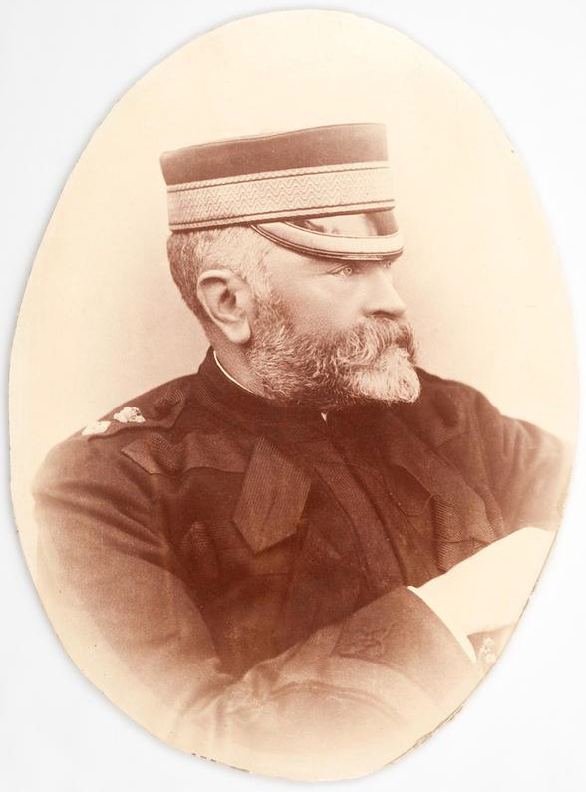 Gerald Henry Fetherston was born in Roscommon, Ireland, in 1830. He was educated at a local school, and as a youth acted as assistant to his father, a doctor, to whom he was apprenticed. He studied at Mercers Hospital and Ledwich Medical School. Dublin, supporting himself by working in chemists' shops. Before being qualified he went to sea as an assistant medical officer, sailing with emigrants to America and Australia. In 1856, then twenty seven, he qualified as L.A.H. Dublin.
Gerald Henry Fetherston was born in Roscommon, Ireland, in 1830. He was educated at a local school, and as a youth acted as assistant to his father, a doctor, to whom he was apprenticed. He studied at Mercers Hospital and Ledwich Medical School. Dublin, supporting himself by working in chemists' shops. Before being qualified he went to sea as an assistant medical officer, sailing with emigrants to America and Australia. In 1856, then twenty seven, he qualified as L.A.H. Dublin.
In the next four years Fetherston made nine voyages to Australia as Ship's surgeon in those famous ships of the Black Ball Line, "James Baines". 'Marco Polo" and 'Lightning'. He was in "James Baines" when she sailed from Liverpool to Melbourne in 64 days, making the return voyage in 63 days.
Fetherston passed the examination for Licentiate of the Colleges of Surgeons and Physicians of Edinburgh in 1860, in which year he settled in Melbourne. Soon after his arrival he was appointed Resident Surgeon to the Lying-In Hospital. Marrying, he lived there for five years, for part of which his wife acted as Matron. His son, Richard Herbert, later Major General Fetherston was born there in 1864.
Gerald Fetherston in 1865 passed a modified examination for MD., University of Melbourne, then allowed for men holding Licentiate Diplomas. In March of that year, he bought the practice of Dr. Job Phillips in Prahran and was prominent in the professional and public life of that city until his death at his home "Kiaora', 152 High St., Prahran on 10th September 1901. Aged 72.
The Prahran practice which extended as far as Oakleigh and Mordialloc, was worked with horses and Fetherston had five buggy horses and one saddle hack. At night the hack was kept saddled and rugged so that the doctor could get quickly away when a call was received.
Fetherston was first elected to the Honorary staff of the Women’s (then the Lying-In Hospital) in 1869, and he continued as an Honorary Medical Officer until 1891. He was also Honorary M.O. to the Benevolent Asylum [then in North Melbourne], to the Blind Asylum, and to the Deaf and Dumb Asylum. He was amongst the first to suggest the founding of the Alfred Hospital on its present site, and worked for the reservation of the land, but being appointed to the Lying-In Hospital, did not become a member of the Alfred medical staff.
Amongst Dr. Fetherston`s public offices were Health Officer of the City of Prahran, member of the Council of the University of Melbourne, member of the Medical Board of Victoria, official visitor to the Mental Asylums of Melbourne, Justice of the Peace and for a long period Chairman of the Prahran Bench.
Fetherston had a lifelong interest in Military affairs. He joined the Victorian Volunteers in 1871, being attached to the Torpedo Corps, now Submarine Engineers. He transferred to the Militia when it was formed in 1884, and in 1890 was appointed Principal Medical Officer, Victoria. He held this appointment until just before his death eleven years later. During the South African war he was responsible for the medical despatch of all Victorian contingents, and on their return dealt with the wounded and sick.
Gerald Fetherston was one of the early members of the Medical Society of Victoria. and of the B.M.A. He was for some years Honorary Treasurer of the Medical Society and its President in I873. He was one of the founders of the Medical Benevolent Association of Victoria, and took an active part in building the original Medical Society Hall in Albert Street, subsequently demolished to make way for the present B.M.A. Building.
Dr. Fetherston, who was twice married, his second wife surviving him, leaves a daughter and two sons. One of the latter, Richard Henry Fetherston, is following in the footsteps of his father, being the holder of a commission as a medical officer in the military service.
Dr Fetherston was buried with full military honours in St Kilda cemetery.
Last updated 3 March 2025.
Main sources: Frank Forster in RWH Book of Remembrance, and Obit, Trove, The Argus, Mon 16 Sep 1901, p.6.
Article by Dr Allan Mawdsley OAM
